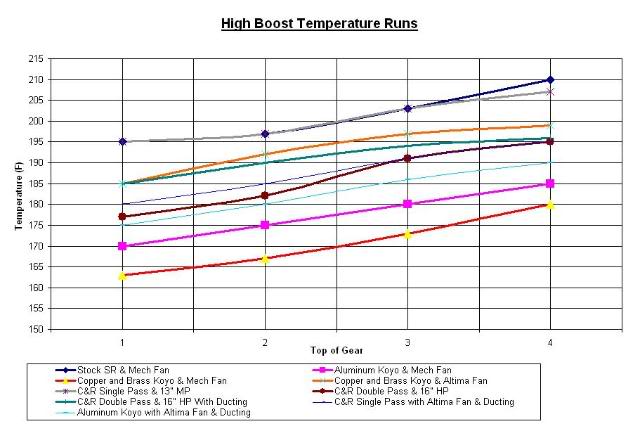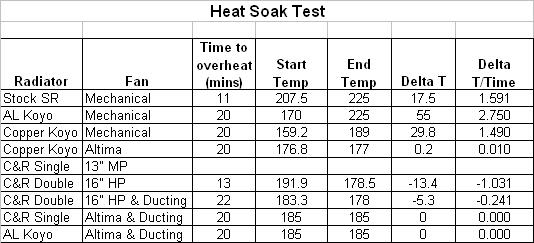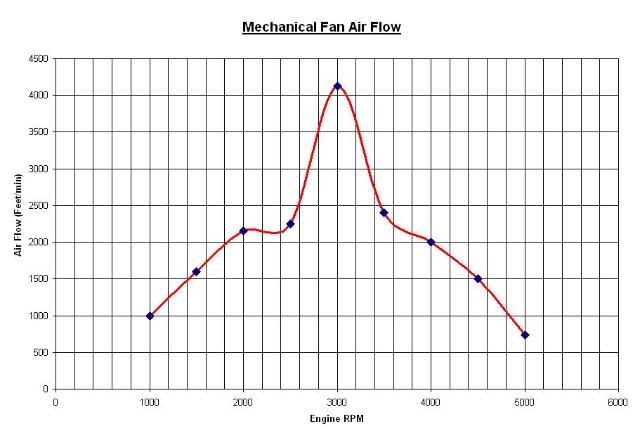| What's Hot! | Products/ Tools | EFI Tuning | Basic Tuning | Advanced Tuning | Chassis Tuning | Advertise with us |
Factual Cooling Data
Great Cooling article with ACTUAL DATA to back up all findings!
October 01-03, 2004 Performed by: David Money, Brad Denton, Kevin Vancleave, and Adrian Romanyszyn
Background:
It has been widely accepted within the 240SX enthusiast community that the SR20DET engine has a tendency to overheat. As a result of this, numerous companies have made various products available to aid in increasing the cooling capacity of the SR20DET and thus decreasing the tendency for the engine to run hotter than desired. However, with the introduction of a number of these components, there has been no substantial testing to quantify their effectiveness, nor has there been any sort of testing to rank the products in terms of performance superiority. As such, this test has been designed this test to do just that. Figures 1 and 2 below shows all of the specimens for this test.
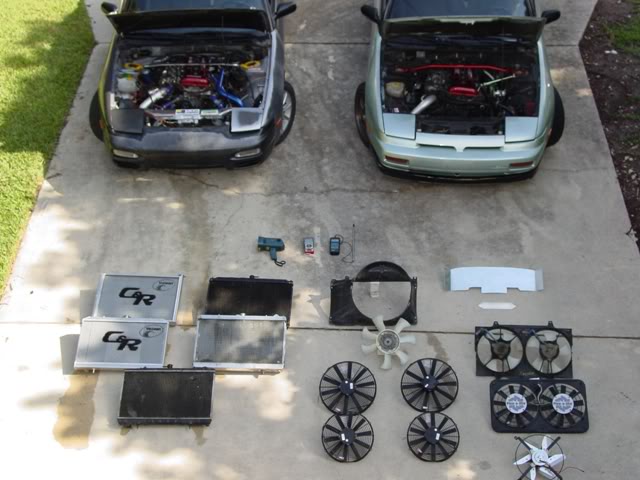
Summary:
* The best bang for the buck combination is the Copper and Brass Koyo Radiator (Essential) with the Altima fans and upper and lower ducting.
* Regardless of radiator design, construction material, cost, or ducting, the typical temperature difference between radiator inlet and outlet is on average only 10 ºF
* Proper ducting of the air entering the radiator can instantly drop the radiator temperatures 20-25 ºF.
* For highway cruising, a cold air intake would offer little to no benefit.
* When parked in stop and go traffic, a cold air intake would make a significant difference.
* The Blitz LM intercooler would easily drop the intake charge temperature down to within 2 degrees of ambient temperature, regardless of boost.
* Having the AC on high, increases the temperature of the air going into the radiator by as much as 70 ºF
* For maximum cooling, the C&R Double Pass with 16 SPAL High Profile fan and ducting cannot be beat.
* The stock SR mechanical fan and shroud is NOT on par with the Flex-A-Lites and Altima fans but is does an acceptable job of cooling.
Test Specimens: Radiators:
1.) Stock SR20DET radiator 2.) Koyo Copper and Brass 3.) Koyo Aluminum 4.) C&R Single Pass 5.) C&R Double Pass
Table 1 below lists the different physical parameters of the various radiators tested.
Fans:
1.) Stock SR20DET Mechanical 2.) Permacool (Single fan with no shroud) 3.) Flex A Lite 220 (Double fan with integrated shroud) 4.) 95 Nissan Altima (Double fan with integrated shroud) 5.) SPAL 13 Low Profile (Single fan with no shroud) 6.) SPAL 13 Medium Profile (Single fan with no shroud) 7.) SPAL 16 Medium Profile (Single fan with no shroud) 8.) SPAL 16 High Profile (Single fan with no shroud)
Approach: It was decided to break the test into two major segments, a driving test segment and a benchtop test segment. For the driving test, a 1992 Nissan S13 Coupe with a redtop SR20DET engine, T25 turbo at 8-12 psi of boost (depending on test), Blitz LM front mount intercooler, Blitz LM air filter and Nismo thermostat was utilized. A picture of this engine setup can be seen below in Figures 3 and 4. Note that the orange wires seen in the pictures are the various thermocouples used to measure the temperatures for the test.
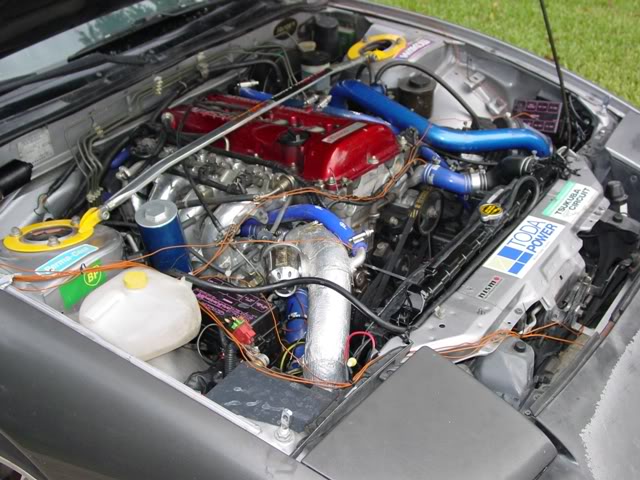
Each one of those testing segments was further broken down into sub-segments as illustrated below:
Driving test 1.) Highway Cruising 2.) High Boost Run 3.) Heat Soak Benchtop test 1.) Unrestricted air flow 2.) Air flow through radiators Driving Test Procedure and Results:
Highway Cruising For the Highway Cruising portion of the driving test, the vehicle was driven over a set course of 9.5 miles at a cruising speed of approximately 65 MPH in 5 th gear at 2850 RPM with boost set at 8 psi. Special care was taken to ensure that the test vehicle was not following too close to other vehicles so as to prevent a blockage of clean air to the front of the vehicle as a result of vehicle wake effects. During the entire duration of the test, the air conditioner was turned on , set on high and also set on recirc?
This would simulate a typical worst case scenario for highway cruising. Nine different temperatures were logged during this test. They were: radiator water inlet, radiator water outlet, ambient air temperature directly in front of the intercooler, air temperature in between the intercooler and the condenser, air temperature in between the condenser and the radiator, air temperature at the air filer, air temperature inside the passenger compartment (for reference), air temperature of the pressurized air entering the intercooler, and finally, air temperature of the pressurized air leaving the intercooler.
All of these temperatures were recorded using a 12 channel Omega chart recorder. A picture of the chart recorder (as installed in the vehicle) can be seen below in Figure 5.
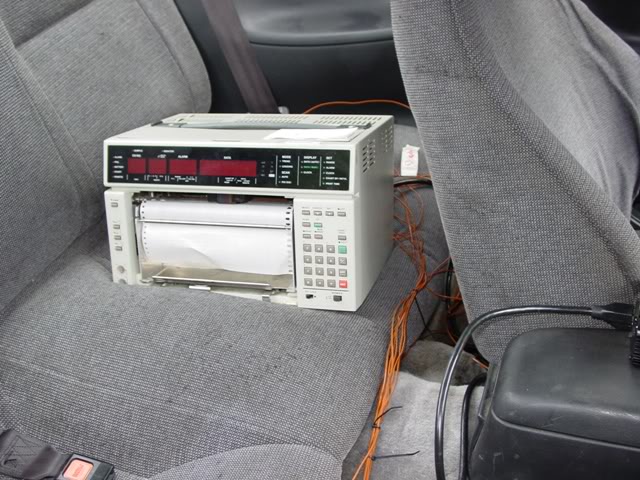
It was agreed upon that the mechanical fan and shroud would be used to test all the radiators (where permissible) for the driving test. Unfortunately, for the C&R radiators, due to both the fan mounting bracket design and, in the case of the double pass, the actual radiator design, it was not possible to test with the mechanical fan and shroud. As such, each of those were tested with the biggest possible SPAL fan that the core face could support.
The first radiator to be tested was the stock SR20DET. The second radiator to be tested was the Aluminum Koyo. The third radiator to be tested was the Copper and Brass Koyo. The fourth radiator to be tested was the C&R Single Pass. The fifth radiator to be tested was the C&R Double Pass. It should be noted that for the highway cruising section of the dynamic test, ALL the radiators performed almost exactly identically with only an average 10 ŽºF water temperature difference between the upper and lower radiator hoses with the water in the upper hose measuring ~188 ŽºF and the water in the lower hose measuring ~178 ºF.
Being that all radiators performed so close in this test, there was no graph in this test and in actuality the data taken from the chart recorder was not put into any sort of spreadsheet as a result. High Boost Runs The High Boost run portion of the test was performed at the conclusion of the Highway Cruising driving test. This test consisted of a launch from dead stop with the air conditioner turned to off. The vehicle was accelerated at wide open throttle, with gear shifting occurring at 7000 RPM, up to a speed of 110 MPH. During this test, temperatures were recorded using the Omega chart recorder as before in the Highway Cruising test. Likewise, water temperature going into the radiator and boost were also recorded using the record feature on the set of Defi gauges installed on the vehicle by the vehicle owner.
At the conclusion of the test, the gauges were replayed and the temperatures at the top of each gear were manually recorded (4 data points). It was chosen to use this data (Defi gauges) instead of the chart recorder data because the sampling rate on the chart recorder was not fast enough to provide meaningful data. The results of the high boost tests can be seen below in Figure 6. It is not important to pay attention to the temperatures in this graph (as they are directly dependant upon the ending temperature of the highway cruising test) but rather the behavior of the graphs. In essence, do the temps plateau off or do they continue to climb?
Figure 6 Upper Radiator Hose Temperatures For Various Radiators/Fans and Ducting Heat Soak Test
At the conclusion of the High Boost test, the Heat Soak test was performed. This consisted of parking the vehicle with the engine idling, the air conditioner set to on with a speed of high and also set to recirc? The test was run for 20 minutes or until the temperature inside the upper radiator hose was reading 225 ŽºF, whichever came first. Again, the Omega chart recorder was set used to record the same nine channels of data as before. The temperatures at the beginning and the conclusion of the test were also recorded. This data is illustrated in tabular form in Table 2.
Table 2 Heat Soak Test Results (Lower Delta T/Time = Better)
***It should be noted that when electric fans were utilized in the driving tests, an HKS fan controller was used to turn the fans on once the ECU saw an engine temp of 185 ŽºF and off again once the ECU saw an engine temp of 175 ºF.***
Benchtop Test Procedure and Results: The benchtop test was broken up into two major segments. The first segment consisted of measuring the unrestricted air flow of each of the fans to be tested. This was achieved by placing each fan (if possible) between two boxes and measuring the air velocity that the fans pulled in. The air velocity was measured at the same spot every time via using the mechanical fan shroud turned upside down and the measuring probe inserted into the shroud at a fixed location. This assured repeatability for all of the tests. Note that due to the design of some of the fans (notably the single fans), this test was not possible. The second segment of the benchtop test consisted of measuring the airflow of each fan through each radiator. When combined with the testing data from the first segment, this gives an analysis of the restriction the radiator designs place on the air passing through them.
Again, the mechanical fan shroud was utilized to ensure that the air velocity probe was in the same location with respect to each radiator. This segment was different from the previous segment in that a radiator was placed in between the mechanical fan shroud and the fan to be tested. A photographic example of this test setup is shown below in Figures 7 and 8. This setup allowed multiple radiators and fans to be tested irregardless of fan shroud design or shape. It should be noted that the power to the fans was provided via an Interstate Megatron battery receiving power from an idling car.
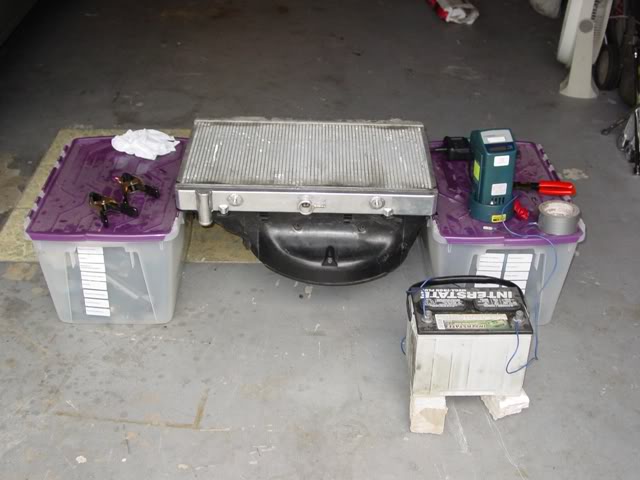
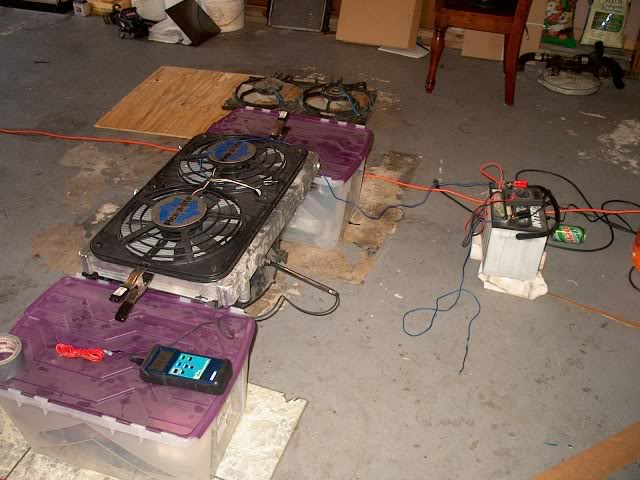
The graphical results of the benchtop test are illustrated in Figure 9 below.
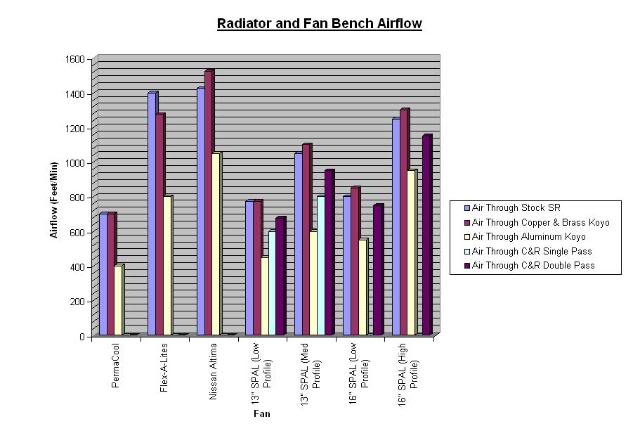
Further Testing as a Result of the Data Being Seen During Testing: After the radiators were tested, it was decided to add some ducting to the front of the car in order to channel the airflow directly into the radiator. A panel was made from cardboard to be placed on top of the area in between the top of the bumper and the top of the condenser core support. This was done to prevent air from taking the path of least resistance and going over the top of the condenser core support.
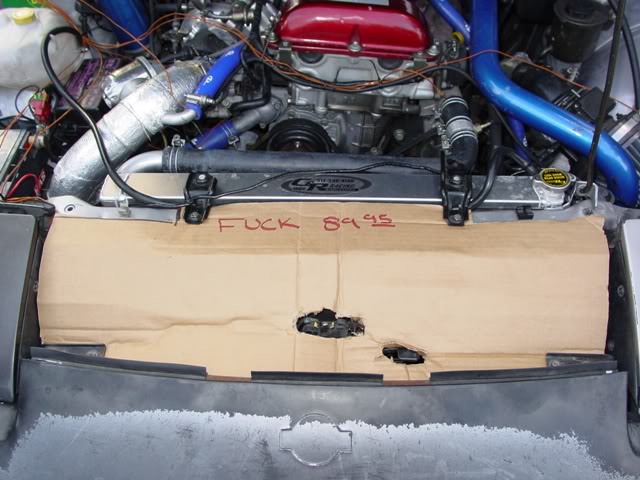
A second panel was made to serve the same function but on the bottom of the bumper. This panel extends from the back of the bottom of the bumper to the front edge of the condenser core support. Note that this panel can be replaced with the factory plastic undertray to get the same effect. The panel and be seen below as Figure 11.

A third bracket was made to induce a low pressure region behind the radiator on the bottom side of the car. This bracket attached to the underside of the radiator mounting directly to the NISMO Power Bar. This bracket is shown below in Figure 12.

A picture of both the lower duct panel and the lower angle bracket installed on the donor vehicle is shown below as Figure 13.
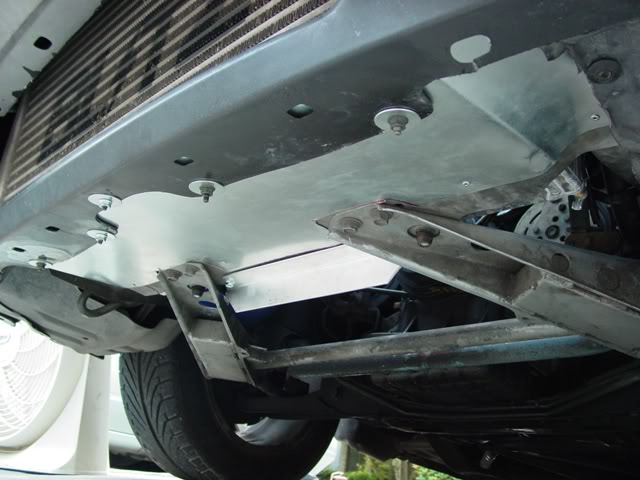
As a result of nothing more than the ducting, when the same driving test was performed (with the C&R Double pass and SPAL High Profile fan), it was noted that an instant 20-25 ŽºF drop in cruising temperatures were seen.
This ultimately resulted in being able to conduct the highway driving part of the test without the fan coming on at all. With regards to the high boost test, the effect was negligible. On the heat soak test, the temps were kept between 174-186 ŽºF via the fan cycling on and off. It was noted that it took less than a minute to cool the temperature 10 ŽºF such that the fan would cycle off. It was later decided to test the C&R Single Pass radiator with the Altima Fans in conjunction with the ducting for a driving test. The Altima fans were chosen due to their high flow rate.
The intent of this test was to see if the ducting would help to increase the performance of the radiator. On the highway cruising, the temperatures fluctuated from 181-188 ŽºF the entire time with a 10 ŽºF difference between the radiator inlets and outlets. For the high boost run, the temperatures appeared to be leveling off. For the heat soak test, the fans basically cycled on and off keeping the temperature in between 174 -186 ŽºF. It was then decided to test the Koyo Aluminum radiator with the Altima fans in conjunction with the ducting for a driving test.
On the highway cruising, the temperatures fluctuated between 174-186 ŽºF (fans cycling on and off entire time) with a 10 ŽºF difference between the radiator inlet and outlet. For the high boost drag runs, the temperatures appeared to be leveling off. For the heat soak test, the fans kept the temperatures in between 174 186 ŽºF via cycling on and off. The results of the High Boost and Heat Soak tests with ducting can be seen in Figure 6 and Table 2 respectively on the previous pages. Finally, the mechanical fan was tested to measure airflow at various engine RPMÃÔ to determine the lock-up RPM of the clutch.
This can be seen graphically below in Figure 14. Note that this data cannot be directly correlated to and compared against the benchtop fan data due to the fact that the mechanical fan measurements were taken on the fan side of the radiator and the benchtop fan measurements were taken on the non-fan side of the radiator. This was due to the fact that no testing procedure was set in place to benchtop test the fans on the fan side of the radiator as a result of the various shrouding methods for the test specimens. What this graph does show is that above approximately 3000 RPM, the effectiveness of the mechanical fan drops dramatically.
Conclusions:
1.) It was proven that the most cost effective solution for an overheating SR20DET is an upper radiator ducting panel (which typically sell for $80-$200) and a lower ducting panel (ala bottom OEM plastic undertray panel). With regards to fans, the Altima fans will outflow almost anything commonly available on the market. That is pretty good considering that they typically cost between $50-$100 a pair.
2.) The Permacool fans should not even be sold on the open market for how the performed.
3.) For radiators, weather they are aluminum, copper and brass, 1 row, 2 row, or 3 row, the temperature difference between inlet and outlet is only 10 ºF. This is only for highway cruising in very light traffic. There is however a difference with respect to boost runs. More water in the radiator means more water to dissipate the heat produced by the engine. This means that it takes longer for the water to heat up. Likewise though, it also means that it is more time for it to cool down too. There was a huge difference in radiator performance for heat soak with the stock SR just falling on its face. What is even worse is that the heat soak test performed in this experiment is not even representative of real stop and go traffic. In the case of real stop and go traffic, the situation is made even worse by the fact that the vehicle in question typically has another vehicle parked mere feet in front of it spewing hot exhaust gasses directly at the radiator of the vehicle behind it. Not the most ideal engine cooling conditions by any means.
4.) It was noted that while driving, the temperature at the air filter was typically within 10 ºF of ambient. However, when parked with the engine and the AC on, the temperature at the air filter climbed to temperatures in excess of 150 ºF. It was also noted the Blitz LM intercooler typically dropped the intake air charge to within 2 ºF of the ambient air temperature.
5.) We were hoping to be able to do testing with regards to weather or not the DM hood prop technique actually does anything for cooling both at speed and at idle. Unfortunately, due to time constraints, we were unable to scientifically test that. However from observation, it was seen that the hood prop does not aid in cooling while driving but without a doubt does at idle conditions. We were also hoping to be able to test the water pump spacer that C&R racing are proposing. Again, due to time constraints (due to weather) this unfortunately just was not possible.
6.) In the future, if we were to do this test all over again, it would be highly preferred to have a true data acquisition system. This would allow for better interpretation of the data and greater accuracy.
Sorting though approximately 50 feet of data (with 9 logged channels) is very time consuming. So what does all of this mean? Well, it does NOT mean that you should sell your current setup and get all new cooling products. In fact, you need to determine what is appropriate for your climate. Running an SR20DET in the summer in Minnesota is much different than running it in Tucson. You need to select components appropriately for your climate and your driving habits. The data contained herein is merely a guide you can use to make informed decisions. Use it wisely.
***Remember*** to check for other relevant information in the columns and article tables.
ATTENTION READER:
If you enjoyed the information and article you just read be sure to check out our newly released book with even more exciting photo's and information:How to Turbocharge and Tune your Engine

Want to know more about your particular Make and Model vehicle? All of these vehicles are covered in the tech, maintenance and repair articles found above. Enginebasics is the wiki or wikipedia of car part, repair, how to and tuning information. Let us be the class 101 for your automotive learning.
| Ford | General Motors GM | Pontiac | Jaguar | Land Rover | Nissan |
| Toyota | Honda | Lexus | Acura | Lotus | Scion |
| Infinity | BMW | Mercedes | Mitsubishi | Ferrari | Maserati |
| Lamborghini | Volks Wagen VW | Saab | Audi | Hyundai | Kia |
| Subaru | Mazda | Chevy | Volvo | Caddilac | Dodge |
| Chrylser | Daewoo | Porsche | Mercury | Freightliner | MG |
Individual Models
| Ford Mustang | Mitsubishi Eclipse | Mitsubishi Evo | Subaru WRX / STI | Dodge Viper | Chevrolet Corvette |
| Nissan Skyline | Honda S2000 | Nissan 350z | Toyota Supra | Chevy Camaro | Lotus Elise Exige |
| Honda Civic | VW Golf | Dodge SRT-4 | Eagle Talon | Acura Integra | BMW M3 |
| Nissan 240sx | Porsche 911 | Acura NSX | Honda Accord | Toyota Camry | Toyota MR2 |
| VW R32 | Dodge Truck | Mazda Rx7 | VW Jetta | Sand Buggy | Nissan Sentra |
For the latest Automotive news and stories visit the websites below |
Our feature Build: An AWD V6 Civic




